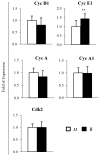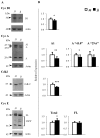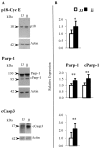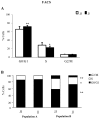Alterations in the cell cycle in the cerebellum of hyperbilirubinemic Gunn rat: a possible link with apoptosis?
- PMID: 24223883
- PMCID: PMC3815147
- DOI: 10.1371/journal.pone.0079073
Alterations in the cell cycle in the cerebellum of hyperbilirubinemic Gunn rat: a possible link with apoptosis?
Abstract
Severe hyperbilirubinemia causes neurological damage both in humans and rodents. The hyperbilirubinemic Gunn rat shows a marked cerebellar hypoplasia. More recently bilirubin ability to arrest the cell cycle progression in vascular smooth muscle, tumour cells, and, more importantly, cultured neurons has been demonstrated. However, the involvement of cell cycle perturbation in the development of cerebellar hypoplasia was never investigated before. We explored the effect of sustained spontaneous hyperbilirubinemia on cell cycle progression and apoptosis in whole cerebella dissected from 9 day old Gunn rat by Real Time PCR, Western blot and FACS analysis. The cerebellum of the hyperbilirubinemic Gunn rats exhibits an increased cell cycle arrest in the late G0/G1 phase (p < 0.001), characterized by a decrease in the protein expression of cyclin D1 (15%, p < 0.05), cyclin A/A1 (20 and 30%, p < 0.05 and 0.01, respectively) and cyclin dependent kinases2 (25%, p < 0.001). This was associated with a marked increase in the 18 kDa fragment of cyclin E (67%, p < 0.001) which amplifies the apoptotic pathway. In line with this was the increase of the cleaved form of Poly (ADP-ribose) polymerase (54%, p < 0.01) and active Caspase3 (two fold, p < 0.01). These data indicate that the characteristic cerebellar alteration in this developing brain structure of the hyperbilirubinemic Gunn rat may be partly due to cell cycle perturbation and apoptosis related to the high bilirubin concentration in cerebellar tissue mainly affecting granular cells. These two phenomena might be intimately connected.
Conflict of interest statement
Figures






Similar articles
-
Sex-specific regional brain bilirubin content in hyperbilirubinemic Gunn rat pups.Biol Neonate. 2006;90(1):40-5. doi: 10.1159/000091843. Epub 2006 Mar 3. Biol Neonate. 2006. PMID: 16534185
-
The Role of Intermittent Hypoxia on the Proliferative Inhibition of Rat Cerebellar Astrocytes.PLoS One. 2015 Jul 14;10(7):e0132263. doi: 10.1371/journal.pone.0132263. eCollection 2015. PLoS One. 2015. PMID: 26172116 Free PMC article.
-
Cerebellar hypoplasia in the hyperbilirubinemic Gunn rat: morphological aspects.Nagoya J Med Sci. 1993 Mar;55(1-4):11-21. Nagoya J Med Sci. 1993. PMID: 8247099
-
Molecular mechanisms of bilirubin induced G1 cell cycle arrest and apoptosis in human breast cancer cell lines: involvement of the intrinsic pathway.Mol Biol Rep. 2022 Nov;49(11):10421-10429. doi: 10.1007/s11033-022-07757-8. Epub 2022 Sep 14. Mol Biol Rep. 2022. PMID: 36104587
-
Expression of the alpha and beta subunits of Ca2+/calmodulin kinase II in the cerebellum of jaundiced Gunn rats during development: a quantitative light microscopic analysis.Acta Neuropathol. 2000 Apr;99(4):393-401. doi: 10.1007/s004010051141. Acta Neuropathol. 2000. PMID: 10787038
Cited by
-
The Role of Bilirubin and the Other "Yellow Players" in Neurodegenerative Diseases.Antioxidants (Basel). 2020 Sep 22;9(9):900. doi: 10.3390/antiox9090900. Antioxidants (Basel). 2020. PMID: 32971784 Free PMC article. Review.
-
Curcumin Prevents Cerebellar Hypoplasia and Restores the Behavior in Hyperbilirubinemic Gunn Rat by a Pleiotropic Effect on the Molecular Effectors of Brain Damage.Int J Mol Sci. 2020 Dec 30;22(1):299. doi: 10.3390/ijms22010299. Int J Mol Sci. 2020. PMID: 33396688 Free PMC article.
-
Models of bilirubin neurological damage: lessons learned and new challenges.Pediatr Res. 2023 Jun;93(7):1838-1845. doi: 10.1038/s41390-022-02351-x. Epub 2022 Oct 27. Pediatr Res. 2023. PMID: 36302856 Review.
-
Bilirubin-Induced Transcriptomic Imprinting in Neonatal Hyperbilirubinemia.Biology (Basel). 2023 Jun 8;12(6):834. doi: 10.3390/biology12060834. Biology (Basel). 2023. PMID: 37372119 Free PMC article.
-
Effect of bilirubin on visuocortical development in preterm infants.J Perinatol. 2025 Feb 5. doi: 10.1038/s41372-025-02213-4. Online ahead of print. J Perinatol. 2025. PMID: 39910190
References
Publication types
MeSH terms
Substances
Grants and funding
LinkOut - more resources
Full Text Sources
Other Literature Sources
Medical
Research Materials

